Use your critical thinking skills to ace your next exam.
Takeaways:
- The key to successful test taking is accurately identifying what the question is asking.
- Carefully read the entire question.
- Nursing test questions give you all the information you need to know to find the answer the question.
By Debra A. Hrelic, PhD, RNC
Group work in higher education
Generational learning preferences
Teach-back: An underutilized tool
Test taking is a skill, whether you’re a student currently enrolled in a nursing program or have just recently returned to school after several years in the workforce. In either case, these tips will help you build your test-taking muscles.
Put on your critical-thinking cap
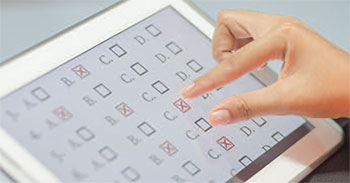

The key to successful test taking is accurately identifying what the question is asking. Don’t focus on the background information; think through the problem or situation as identified in the question. Whether it’s a knowledge, application, delegation, or medication question, most questions are designed to test critical thinking. Several strategies will help you problem-solve your way to a correct answer.
Reword the question
Carefully read the entire question. Don’t rush through it or stop halfway through because you assume that you know what’s being asked. Reword the stem to make it easier to understand, and answer the question. Look for hints or key words, such as most, all, first, best, primary, initial, always, and never. On a paper exam, underline or circle those words so that you don’t forget them when seeking your answer; on a computer exam, write them on scrap paper.
Questions with phrases in the stem stating “further teaching is needed” may indicate that the answer contains incorrect information or has a negative connotation. For example:
The nurse has completed discharge teaching with the parents of a child suffering from atopic dermatitis. The nurse determines that further teaching is needed when the mother states it is most important upon discharge to:
a. Maintain a high-humidified environment to keep her child’s skin moist.
b. Keep her child’s fingernails trimmed short and with no rough edges.
c. Wrap her child’s hands in soft cotton gloves.
d. Dress her child in loose soft clothing.
The correct answer is “a.” Since “further teaching is needed,” you’re looking for an answer that shows what the patient got wrong. In this case, a humid environment would increase bacterial growth and cause clothing to rub and irritate the child’s skin.
The stem of an answer that holds positive or correct information might be worded like this: “the patient demonstrates knowledge and understanding.” For example:
When a nurse is providing education to a patient newly diagnosed with diabetes, which action demonstrates learning has occurred?
a. The nurse presented information to the patient about diabetes.
b. The patient demonstrates how to inject insulin.
c. The patient watches a film on diabetes.
d. A primary care provider gives the patient a pamphlet on diabetes.
The correct answer is “b.” “Learning has occurred” is a positive statement, so you’re looking for a statement that demonstrates a learned action. “B” is the only answer where the patient demonstrates a learned behavior that’s related to what has been taught.
Choosing the correct answer may mean choosing among several answers that have some degree of correct information. This is where critical thinking especially comes into play. Go back to your interpretation of what the question was really asking, and the correct answer should be apparent.
Answer the question first
Try answering the question before looking at the choices. Decide what the question is asking, what you believe the answer is, and then go to the choices and look for it. If your answer is there, you can choose it and move on. If not, either reword the question or look for patterns and relationships in the answers. Do you see information in the choices related to what you thought was the correct answer? If not, go back to the question, reread it, and be sure you understand what’s being asked.
If you have an idea what the answer is, use that to eliminate incorrect answers. Read remaining choices to obtain clues. Reread the question and try to narrow down the answers by applying knowledge. Is the question asking for a course of action or a demonstration of knowledge? Look for clues in the question and in the remaining answers. Remember not to assume information. Nursing questions give you all the information you need to know. Don’t read into them, wondering, for example, whether the patient is or isn’t febrile. If it isn’t mentioned in the stem, then it isn’t relevant to the answer.
Eliminate wrong answers
After reading and rewording the question, read only the first answer choice. Does it answer your reworded question? If it doesn’t, eliminate it from consideration. If it does or if you’re not sure, keep it as a possibility. Follow this method with each of the remaining three choices, eliminating those that don’t answer the question. This technique eventually will leave you with only one choice.
Time is of the essence
You may be wondering if you’ll have time to follow these steps with each question. The answer is almost always yes. Most students waste time staring at and rereading questions they don’t understand rather than following these simple steps and using their critical-thinking skills. (See Don’t panic, strategize.)
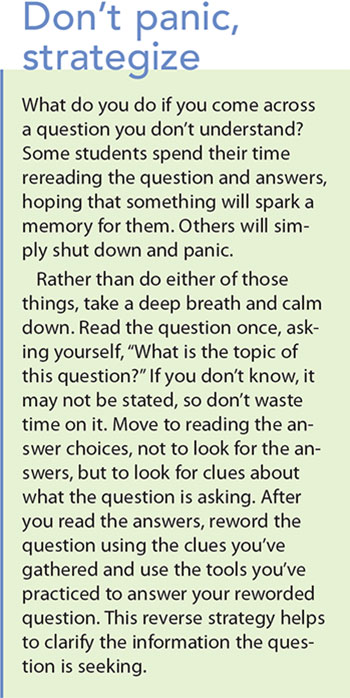

If you have concerns about any questions and you’re taking a paper exam, mark them to come back to after completing everything else. However, keep these caveats in mind: If you’re filling out a form where you fill in circles with your answers, you may forget to leave a circle blank for the skipped question you want to revisit. The grading of your entire test may be thrown off, resulting in failure. Also, skipping a question on a computerized test to return to later may not be an option.
NCLEX-RN® preparation
The computerized National Council Licensure Examination for Registered Nurses (NCLEX-RN), the entry-to-practice examination for RNs in the United States, is organized into four categories of patient need to define nursing actions and competencies: safe and effective care environment, health promotion and maintenance, psychosocial integrity, and physiological integrity. (See NCLEX-RN categories.)
Most of the questions on the NCLEX-RN exam are multiple choice. You’ll also encounter alternative-format questions such as multiple response, fill-in-the-blank, ordered response, and hot spots (which require you to identify and click on a specific area of the body [hot spot] on a graphic with your mouse). Questions may include charts, tables, graphics, sound, or video. The National Council of State Boards of Nursing (NCSBN) website has information about item formats with examples.
Every nursing class and every exam you take in school helps prepare you for taking your NCLEX-RN. And studies show that nursing students who complete between 400 to 500 NCLEX-style review questions for each class they take are better prepared for nursing class exams and are more likely to pass their NCLEX-RN examination.
The more you practice taking NCLEX-type exams, the better you do on them and the less anxious you’ll feel while taking them. You can find practice questions relevant to all areas of nursing in NCLEX-RN preparation books and online. You also can use smartphone, computer, and tablet apps. Check with faculty and local and school libraries for additional resources and recommendations. Some students share preparation books, trading them from class to class.
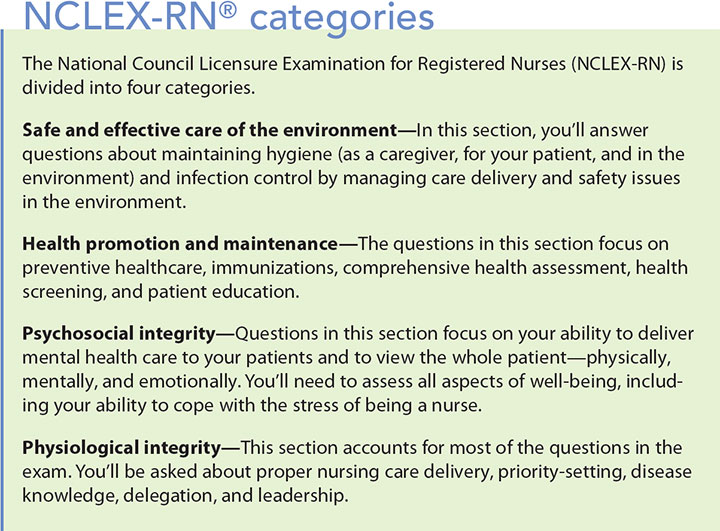

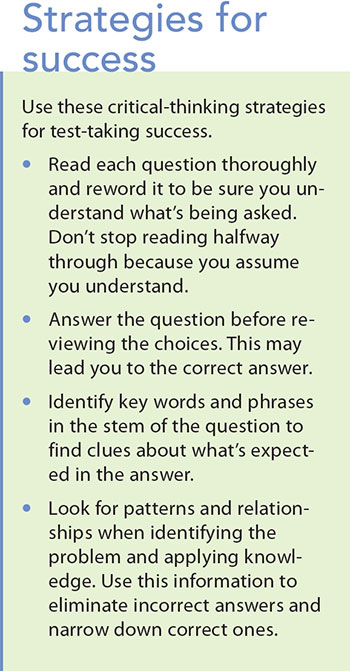

Ace your next test
Whether you’re a practicing nurse or a student, use your critical-thinking skills and these tips to ace your next test. (See Strategies for success.)
Debra A. Hrelic is the RN-BSN program coordinator at the University of North Carolina in Wilmington.
Selected reference
National Council of State Boards of Nursing. NCLEX-RN® Examination: Detailed Test Plan. April 2016.
NCLEX strategies: Critical thinking & rewording questions. Kaplan Test Prep.
NCLEX-RN® question types. Kaplan Test Prep.

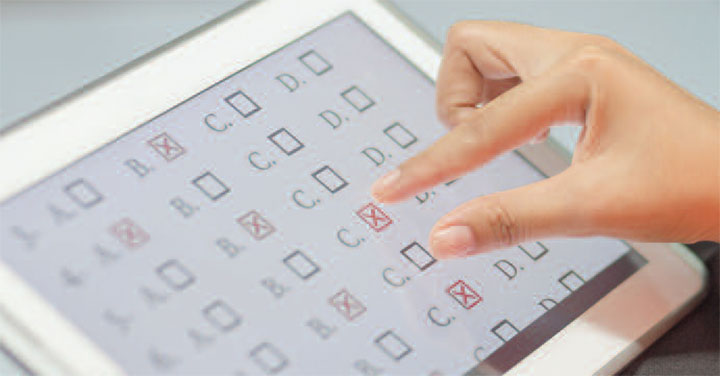

















3 Comments.
Hi!
What would you reccomend if a child can’t concentrate while doing a test?
Thanks!
Knowing and understanding the contents of the exam by heart is important but most people overlook preparing for “how” they’re gonna take the exam and what approach would they take in answering it. Knowing how to go through questions and answering them efficiently would help increase your chances of scoring high.
I’m going to be taking some summer classes next year as I’m saving up for tuition now. Anyways, I know that there will be tests and quizzes so I’ll for sure have to study hard for them. As you said, there will probably be some multiple-choice questions which of course, I’ll have to pay extra attention to as they make you think outside the box quite a bit.